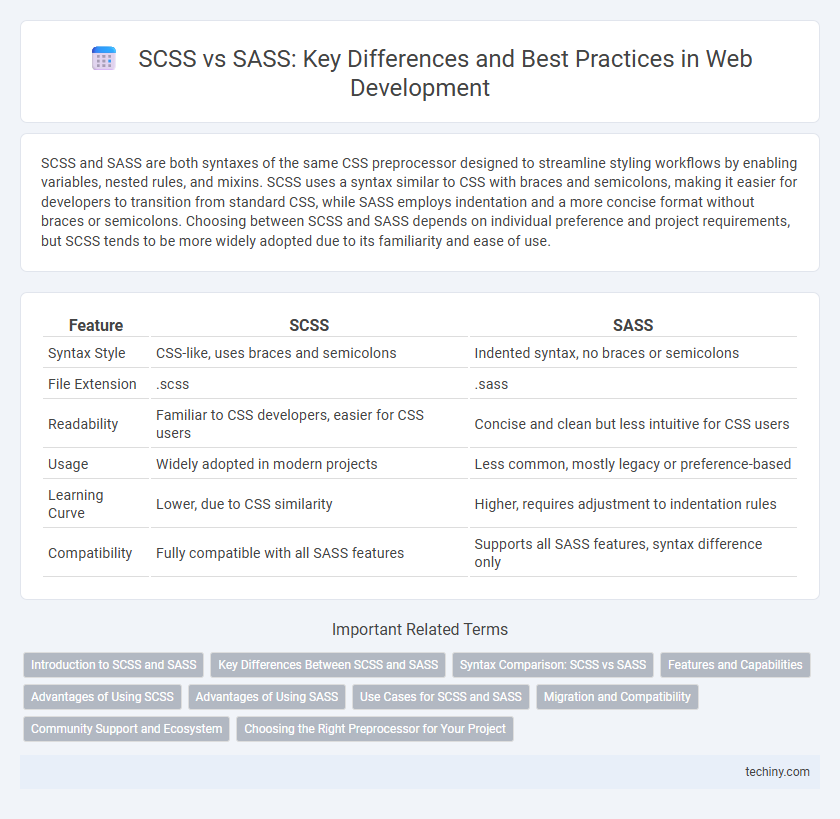SCSS and SASS are both syntaxes of the same CSS preprocessor designed to streamline styling workflows by enabling variables, nested rules, and mixins. SCSS uses a syntax similar to CSS with braces and semicolons, making it easier for developers to transition from standard CSS, while SASS employs indentation and a more concise format without braces or semicolons. Choosing between SCSS and SASS depends on individual preference and project requirements, but SCSS tends to be more widely adopted due to its familiarity and ease of use.
Table of Comparison
| Feature | SCSS | SASS |
|---|---|---|
| Syntax Style | CSS-like, uses braces and semicolons | Indented syntax, no braces or semicolons |
| File Extension | .scss | .sass |
| Readability | Familiar to CSS developers, easier for CSS users | Concise and clean but less intuitive for CSS users |
| Usage | Widely adopted in modern projects | Less common, mostly legacy or preference-based |
| Learning Curve | Lower, due to CSS similarity | Higher, requires adjustment to indentation rules |
| Compatibility | Fully compatible with all SASS features | Supports all SASS features, syntax difference only |
Introduction to SCSS and SASS
SCSS and SASS are two syntaxes of the Sass (Syntactically Awesome Stylesheets) preprocessor, designed to extend CSS with variables, nested rules, and mixins for improved maintainability and efficiency. SCSS syntax closely resembles standard CSS, making it easier for developers to adopt, while SASS uses an indented syntax without braces or semicolons, offering a cleaner and more concise style. Both syntaxes compile into standard CSS, enhancing web development workflows by enabling dynamic styling and better code organization.
Key Differences Between SCSS and SASS
SCSS uses a syntax similar to CSS with braces and semicolons, making it easier for developers familiar with CSS to adopt, while SASS employs an indented syntax without braces or semicolons, emphasizing simplicity and readability. SCSS supports all CSS features and can be compiled directly into CSS, whereas SASS requires indentation to define nesting, which can reduce potential syntax errors. The choice between SCSS and SASS affects code maintainability, with SCSS favored for compatibility and SASS for cleaner, more concise code structure.
Syntax Comparison: SCSS vs SASS
SCSS uses a syntax similar to CSS with braces and semicolons, making it easier for developers familiar with CSS to adapt quickly. SASS employs an indented syntax without braces or semicolons, offering a cleaner and more concise code structure. Both syntaxes compile to the same CSS, but SCSS supports more traditional CSS syntax, while SASS focuses on simplicity and readability.
Features and Capabilities
SCSS syntax offers full CSS compatibility, enabling developers to write stylesheets with familiar CSS conventions while leveraging variables, nested rules, mixins, and inheritance to streamline code management. SASS uses an indented syntax without braces or semicolons, providing a more concise and readable format, with the same powerful features such as functions, control directives (if, for, while), and partials for modular stylesheet organization. Both SCSS and SASS support advanced features like color manipulation, mathematical operations, and selector interpolation, enhancing dynamic styling capabilities in complex web development projects.
Advantages of Using SCSS
SCSS offers improved syntax compatibility with CSS, allowing developers to write stylesheets using familiar CSS rules while taking advantage of advanced features like variables, nesting, and mixins. Its seamless integration with existing CSS code makes SCSS ideal for incremental adoption in large projects, reducing refactoring time and errors. Enhanced readability and maintainability of style code contribute to more efficient collaboration and faster development cycles in web projects.
Advantages of Using SASS
SASS offers powerful advantages in web development due to its advanced features like nested syntax, variables, and mixins, which enhance code maintainability and reduce redundancy. It supports both indented syntax (SASS) and SCSS, providing flexibility for developers to choose their preferred style without sacrificing functionality. The ability to modularize stylesheets and automate repetitive tasks accelerates development workflows and improves project scalability.
Use Cases for SCSS and SASS
SCSS is widely used for projects requiring CSS compatibility and easier integration with existing stylesheets, making it ideal for large-scale web applications and teams transitioning from plain CSS. SASS, with its indented syntax, excels in smaller projects or those favoring concise, clean code and faster writing without the need for curly braces or semicolons. Both preprocessors enhance CSS with variables, nesting, and mixins, but SCSS's similarity to CSS syntax suits developers aiming for gradual adoption and collaboration across diverse skill levels.
Migration and Compatibility
SCSS and SASS both extend CSS with advanced features, but SCSS syntax is fully compatible with CSS, simplifying migration from traditional stylesheets. When migrating from SASS to SCSS, developers must adjust to SCSS's CSS-like syntax while preserving mixins, nesting, and variables for seamless functionality. Compatibility with most modern build tools and preprocessors ensures SCSS is widely supported, reducing integration issues in ongoing web development projects.
Community Support and Ecosystem
SCSS and SASS benefit from strong community support, with SCSS enjoying wider adoption due to its CSS-like syntax that lowers the learning curve for developers. The SCSS ecosystem features extensive libraries, frameworks like Compass, and robust integration with build tools such as Webpack and Gulp, enhancing workflow efficiency. While SASS maintains a loyal user base, SCSS's compatibility with existing CSS resources and comprehensive documentation drives greater ecosystem growth and developer collaboration.
Choosing the Right Preprocessor for Your Project
Choosing between SCSS and SASS depends on your team's familiarity and project requirements, as SCSS offers a syntax closer to traditional CSS, making it more accessible for developers. SASS, with its indentation-based syntax, provides a cleaner and more concise code structure, which can improve readability and maintainability in larger projects. Evaluating factors like project complexity, team preferences, and integration capabilities with build tools will help determine the ideal preprocessor to streamline your web development workflow.
SCSS vs SASS Infographic

 techiny.com
techiny.com